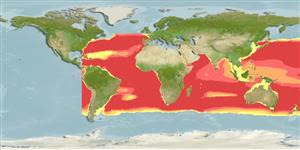Common names from other countries
>
Myctophiformes (Lanternfishes) >
Myctophidae (Lanternfishes) > Diaphinae
Etymology: Diaphus: Greek, dis, dia = through + Greek, physa, phyo = to beget, to have as offspring (Ref. 45335).
More on authors: Goode & Bean.
Environment: milieu / climate zone / depth range / distribution range
Ecología
marino batipelágico; no migratorio; rango de profundidad 0 - 6000 m (Ref. 58018). Deep-water; 50°N - 49°S, 82°W - 180°W
Eastern Atlantic: from 40° to 17°N, from 19°S to Subtropical Convergence zone. Western Atlantic: USA to about 20°N, from Brazil to Subtropical Convergence. Indian Ocean: west of 70°E between 5°S-38°S. Western Pacific: between 0° and 29°N, Southeast Asian seas, New South Wales, Australia (Ref. 7300) and New Zealand (Ref. 5755). Central and Southeast Pacific.
Tamaño / Peso / Age
Maturity: Lm ? range ? - ? cm
Max length : 15.0 cm SL macho / no sexado; (Ref. 4066)
Short description
Claves de identificación | Morfología | Morfometría
Espinas dorsales (total) : 0; Radios blandos dorsales (total) : 15 - 17; Espinas anales: 0; Radios blandos anales: 15 - 16.
High-oceanic and mesopelagic species (Ref. 4066), found between 501-700 m during the day and between 40-175 m during the night, exhibiting size stratification with depth (Ref. 4479). Probably spawns in deep water during spring (Ref. 4479).
Life cycle and mating behavior
Maturities | Reproducción | Spawnings | Egg(s) | Fecundities | Larva
Hulley, P.A., 1990. Myctophidae. p. 398-467. In J.C. Quero, J.C. Hureau, C. Karrer, A. Post and L. Saldanha (eds.) Check-list of the fishes of the eastern tropical Atlantic (CLOFETA). JNICT, Lisbon; SEI; Paris; and UNESCO, Paris. Vol. 1. (Ref. 4479)
IUCN Red List Status (Ref. 130435)
CITES (Ref. 128078)
Not Evaluated
Threat to humans
Harmless
Human uses
Pesquerías: sin interés
Herramientas
Special reports
Download XML
Fuentes de Internet
Estimates based on models
Preferred temperature (Ref.
115969): 2 - 5.8, mean 3.2 (based on 3796 cells).
Phylogenetic diversity index (Ref.
82804): PD
50 = 0.5000 [Uniqueness, from 0.5 = low to 2.0 = high].
Bayesian length-weight: a=0.01000 (0.00436 - 0.02294), b=3.04 (2.86 - 3.22), in cm Total Length, based on LWR estimates for this Genus-body shape (Ref.
93245).
Nivel trófico (Ref.
69278): 3.0 ±0.00 se; based on food items.
Resiliencia (Ref.
120179): Medio, población duplicada en un tiempo mínimo de 1.4-4.4 años (Preliminary K or Fecundity.).
Fishing Vulnerability (Ref.
59153): Low vulnerability (10 of 100).
